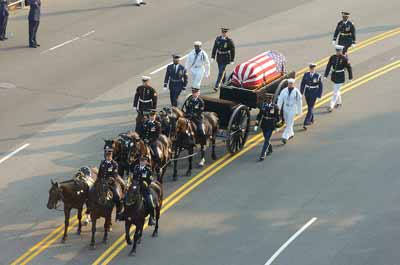Who Was Black Jack?
Black Jack was a horse famous for his role as the riderless horse in over 1,000 funerals.
Below: 1963 photo of Black Jack in the funeral procession of President John F. Kennedy.
 /
/
Black Jack (1947 - 1976) was born on January 19, 1947. While some accounts describe the mature Black Jack as "coal black," he was actually a dark chestnut. He was named in honor of General Of The Armies John Joseph Pershing (1860 - 1948), a highly decorated and respected Army General whose nickname was Black Jack.
Black Jack has the distinction of being the last Quartermaster–issued horse in the United States Army. He was branded on the left shoulder with the Army's "US" brand, and his Army serial number, 2V56, on the left side of his neck.
Black Jack's Career Begins
When Black Jack began his military career he was what might be politely referred to "as a real pill." Or maybe handful. His initial Army training was at the remount station at Fort Reno, Oklahoma. By all accounts, it went poorly.
The original plan was for Black Jack to be trained to ride, but the dark, handsome horse refused to show any interest in becoming a riding horse. He bucked repeatedly, throwing his riders off over and over.
Without any indication he would adjust to life as a saddle horse, he was moved to the Caisson Platoon of the 3rd U.S. Infantry Regiment at Fort Myer, Virginia. (This famous platoon is often referred to by its nickname, "The Old Guard.")
Did you know? A "caisson" is a horse-drawn, two-wheeled cart designed to carry artillery ammunition. It is also used to carry the casket of the deceased in a military or state funeral.
Below: A caisson in the 2004 funeral procession of President Ronald Reagan. Note that all 6 of the horses pulling the caisson are saddled, but only three are being ridden.
There is an additional horse and rider not harnessed to the caisson riding at the front next to harnessed horses. Although it can't be seen in the photo, a riderless horse followed the caisson.

A...... What Kind Of Horse?
Black Jack arrived at Fort Meyer in late 1952 when he was six years old. He continued to resist being ridden so he got a new job assignment as a caparisoned horse.
A caparisoned horse, in case you're not familiar with the term, is a horse that wears a caparison, which is a blanket put on a horse either for decoration or protection. This blanket can be large or small, plain, decorated, dark, or vibrantly colored. Therefore, a "caparisoned horse" is a horse that wears a caparison.
However, in the United States the phrase "caparisoned horse" has become synonymous with a riderless horse used in the funeral procession of a military officer or high-ranking leader. In these circumstances a caparisoned horse wears a caparison (in this case, a special saddle blanket), saddle, and bridle. They also carry boots turned backwards in the stirrups, and sometimes a backwards saber, both of which poignantly signify the death of the person they are honoring.
A caparisoned horse follows the horse-drawn caisson carrying the casket in a formal funeral procession. It was Black Jack's new job to become a caparisoned horse.
A Rough Start
At the beginning, Black Jack seemed to dislike his job as a caparisoned horse nearly as much as he disliked his failed career as a saddle horse. His first time in a funeral procession he was anything but the quiet, dignified, member of the ceremony he was supposed to be.
In fact, his rowdy behavior as he was led behind the caisson was so obnoxious - in the eyes of his military superiors, at least - that they felt they owed the family of the deceased an apology.
Before they could express their regrets, however, the family surprised them by saying how wonderful they thought Black Jack's presence in the procession had been. Instead of viewing him as barely-controlled and undignified, they felt he had demonstrated the energy and spirit of their beloved deceased.
In spite of his rough start, Black Jack's career assignment as a caparisoned horse continued. Before it was over, he would serve as a caparisoned horse in over 1,000 United States Armed Forces Full Honors Funerals.
JFK's Funeral and Fame
Black Jack became famous due to an American tragedy.
On Friday, November 22, 1963, American President John F. Kennedy was killed by an assassin's bullet. Three days later, on November 25, all of America and much of the world watched his funeral on television. It was the first televised state funeral in American history. The American public watched every detail in stunned disbelief, along with an amazement at the ceremony of it all.
Much of what the public saw unfolding before them on television was totally new to them. Most of them had never seen a horse-drawn caisson with a casket, let alone one carrying the the flag-draped casket of their President. Few of them had ever even heard of a caparisoned horse, and now they were watching one, Black Jack, as he was led behind the caisson.
Millions of people watched the funeral on television that day. They could hear the solemn beat of drums, the wheels of the caisson rolling on the hard streets, and the solemn, dignified sound of the hooves of the 6 gray horses pulling the flag-draped casket in the caisson.
They also saw the beautiful, dark, riderless Black Jack following behind. They stared at his perfectly groomed coat, the gleaming saddle, the boots turned backwards in the stirrups......and his antics.
Below: Black Jack not holding still during the funeral of President John F. Kennedy, 1963.
 /
/
Black Jack was 16 years old at the time of Kennedy's funeral. Various descriptions of him we have found alternately describe him, at that time of his life, as a horse that had become more business-like at his job (if still a bit quick to trot and prance), or a horse that was as unpredictable and as rowdy as ever.
So, while we're not sure what Black Jack's behavior had been like in the years after his first funeral procession, he was an unquestionable handful during Kennedy's funeral.
Written accounts variously describe him as wild or uncontrollable. Black Jack's young handler for the funeral, Arthur Carlson, had his foot painfully stomped on by the whirling, dancing, pulling, horse, causing the young man to think several of his toes had been broken (they weren't). Carlson also said it was all he could do merely to hang on to Black Jack.
The Nation Loved Him
After Kennedy's funeral, Black Jack was a star. Many people even considered him a national treasure. Maybe that's because his wild behavior, televised to a stunned nation during the funeral, was a distraction from the terrible events of the previous few days. Maybe it was because his role as a caparisoned horse in the funeral procession, likely the first one many of them had ever seen, somehow struck an emotional chord with them.
Or maybe they just loved him for his beauty and independent nature.
Whatever the reason, Black Jack had endeared himself to the nation. People wanted to know his name, and why he carried a saddle with boots turned backwards in the stirrups. School children came in droves to his stable at Fort Meyer to meet him. Even President Kennedy's widow, Jacqueline Kennedy, became a fan.
Black Jack continued to perform his duties as a caparisoned horse for nearly 10 years after Kennedy's funeral. In total, he served in the procession in over 1,000 funerals, including four state funerals:
- President John F. Kennedy (1917 – 1963)
- General Douglas MacArthur (1880 – 1964)
- President Herbert Hoover (1874 – 1964)
- President Lyndon B. Johnson (1908 – 1973)
Did you know? A state funeral is a funeral held to honor people of important national significance. Stare funerals are typically highly publicized, and involve a great deal of protocol and carefully planned ceremony.
Buried With Full Military Honors
Black Jack was retired on June 1, 1973. Prior to his death on February 6, 1976 his health deteriorated badly, and the painful decision was made to euthanize him. At the time of his death he was 29 years old.
After his death Black Jack was cremated and his remains were buried on Summerall Field in Fort Myer, Virginia. He was buried with full military honors, making him one of only four horses in United States history with this distinction.
Did you know? The four horses in United States history buried with full military honors are:
- Black Jack (1947 - 1979)
- Chief (1932 - 1968) - Chief was sold to the United States Army in 1940 and has the distinction of being the Army's last living operational cavalry mount.
- Comanche (1962? - 1891) - Comanche is a famous Army mount that survived the infamous Battle of the Little Bighorn (aka "Custer's Last Stand") in 1876.
- Staff Sergeant Reckless (1948? - May 13, 1968) - During the Korean War, a chestnut mare named Reckless was trained as a pack horse. She excelled in her service, carrying supplies, ammunition, and wounded servicemen. She was awarded numerous military honors, and held the official rank of staff sergeant.
